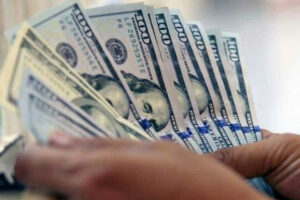Weak US outlook to hit remittances
A SLOWDOWN in US consumption could hurt Philippine remittances and exports, though this is still outweighed by domestic risks, Fitch Ratings said.

By Luisa Maria Jacinta C. Jocson, Reporter
A SLOWDOWN in US consumption could hurt Philippine remittances and exports, though this is still outweighed by domestic risks, Fitch Ratings said.
“Fitch expects some of the main channels of impact would be via weaker US demand for goods imports and outbound tourism, lower remittances and the effects on financial channels and commodity prices,” it said in a report.
The rating firm expects US consumption growth to decelerate gradually over the next 12 months and slow to 1.4% in 2025 from 2.2% this year.
“A notably sharper slowdown could have big implications for emerging market sovereigns, though we view this risk as low,” it added.
US consumer confidence dropped by the most in three years in September amid mounting fears over the labor market, though more households planned to buy a home in the next six months, Reuters reported.
The Conference Board’s consumer confidence index dropped to 98.7 last month from an upwardly revised 105.6 in August. The decline was the largest since August 2021. Economists polled by Reuters had forecast the index rising to 104 from the previously reported 103.3.
The Philippines is among the countries that could experience spillover effects from the anticipated weakness, Fitch Ratings said.
“The report mentions the Philippines as one of the countries with relatively smaller, but still potentially significant, exposure to US consumer spending,” Krisjanis Krustins, director at Fitch Ratings’ Asia-Pacific Sovereigns team and primary analyst for the Philippines, said in an e-mail.
The report showed the impacts of muted consumption on various channels in emerging markets (EM) like the Philippines, such as exports. “The US is the most important export market for many EMs, so weaker US domestic demand could have significant repercussions for their export earnings,” it said.
It noted that the Philippines is among the countries where goods exports to the US account for 3-5% of economic output. This indicates a “slightly lower, but still potentially significant exposure.”
Latest data from the local statistics authority showed that the United States remained the top destination for Philippine-made goods in July, with exports valued at $1.06 billion, equivalent to 16.9% of the total for the month.
“In some cases, such as China’s, this metric may understate exposure as goods exports to other countries may be part of industrial supply chains that ultimately depend on US consumer demand,” Fitch Ratings added.
Meanwhile, remittance inflows may also be dampened by the expected slump in US consumer demand.
“A slowdown in US consumption generally affects US economic activity more broadly, with negative repercussions for the country’s labor market and income growth.”
Fitch Ratings said this could affect the value of remittances sent to emerging markets “as a high share of migrant workers are employed in service sectors that are more likely to be hit if consumption slows.”
“The US’ large migrant and diaspora communities mean it is also a leading source of remittances for many other EMs,” it said. “These include both countries where remittances are large as a share of GDP (gross domestic product) — as in Armenia, Cabo Verde, Georgia, Ghana, Nigeria, the Philippines and Tunisia,” it added.
Data from the Philippine central bank showed that cash remittances from overseas Filipino workers (OFWs) rose by 2.9% to $19.332 billion in January to July. The US accounted for 41.1% of the cash remittances.
In 2023, personal remittances hit a record $37.2 billion and accounted for 8.5% of the Philippine economy.
“Nonetheless, we believe there would likely need to be a large impact on US labor markets to have a significant impact on remittance flows from the US,” Fitch Ratings said.
“Remittances tend to be resilient and are more stable than capital flows, as they are influenced by many factors beyond economic activity levels in the source country, including altruistic motives driven by circumstances in the receiving country,” it said. “Remittances held up well during the economic disruption associated with the COVID-19 (coronavirus disease 2019) pandemic.”
Meanwhile, Mr. Krustins said domestic factors continue to pose a bigger risk for the Philippines than external headwinds.
“Still, domestic demand is the key driver of the Philippines’ 5-6% growth at the moment, so in terms of magnitude, more local risks represent the main potential downsides,” he said. “These could include a renewed spike in inflation, which has been weighing heavily on consumer spending. Climate is also a persistent risk.”
Inflation eased to a seven-month low of 3.3% in August from 4.4% in July. The central bank expects inflation to settle at 3.4% this year.
“Structurally, one of the key challenges for the Philippines’ economy is addressing weaknesses in infrastructure, human capital and the regulatory framework, to enable more private and foreign investment; in the absence of this, growth could stabilize at lower levels,” he added.
The government targets to spend 5-6% of economic output on infrastructure annually.
DOLLAR WEAKNESS
Meanwhile, emerging market currencies could get a boost from a weaker US dollar, Fitch Ratings said.
“A sharper-than-expected US consumption slowdown could affect the outlook for US interest rates, which could be lower than under the baseline, and the US dollar, which could consequently be weaker,” it said.
“A weaker US dollar could support export competitiveness in EMs with dollarized economies. It would also reduce the burden of repaying US dollar-denominated debt in local currency terms,” it added.
Mr. Krustins said the start of the US Federal Reserve’s rate-cutting cycle would also support the peso.
“The start of the Fed easing cycle should in general be supportive of the value of the Philippine peso, similar to other EM currencies and indeed, the peso has strengthened from its weak point in June,” he said.
The Federal Reserve last month cut interest rates by 50 basis points to 4.75%-5%, the first reduction since 2020 that Fed Chairman Jerome H. Powell said was meant to demonstrate policy makers’ commitment to sustaining a low unemployment rate.
“However, we expect the Bangko Sentral ng Pilipinas to maintain a relatively low interest rate differential with respect to the Fed, compared with historical norms,” Mr. Krustins said. “This, combined with a shift to a structural current account deficit position, could limit the upside for the Philippines’ currency.”























